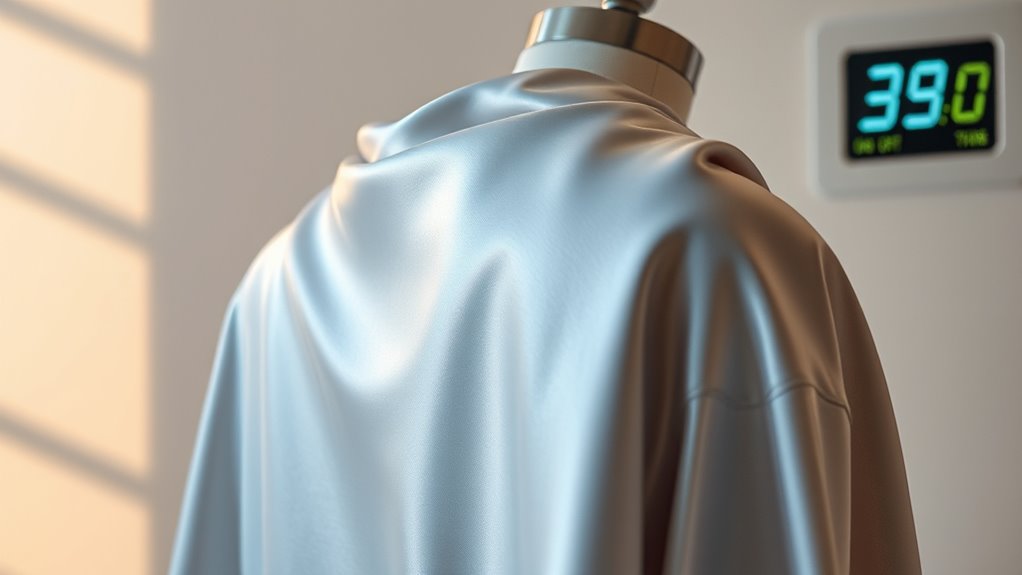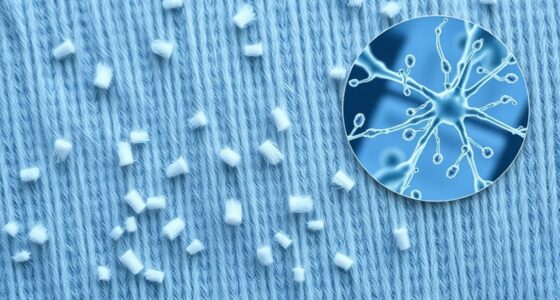Phase-change materials (PCMs) in fabrics automatically help you stay comfortable by absorbing excess heat when you get hot and releasing it when you cool down. They change phase from solid to liquid at specific temperatures, providing cooling or warming without needing external power. This technology reduces reliance on air conditioning and heating, saving energy and money. If you want to discover more about how these fabrics work and their benefits, keep exploring these innovative solutions.
Key Takeaways
- PCMs in fabrics absorb excess body heat, providing automatic cooling without external power.
- Embedded phase-change materials enable garments to regulate temperature on demand.
- These textiles enhance comfort and energy efficiency by reducing reliance on external heating or cooling systems.
- Ongoing advancements improve durability and expand applications in smart clothing solutions.
- PCM-enhanced fabrics support sustainable temperature management, lowering overall energy consumption.

Have you ever wondered how some materials can store and release thermal energy efficiently? It’s a fascinating process, especially when applied to fabrics designed for thermal regulation. Phase-change materials (PCMs) are at the forefront of this innovation, enabling clothing to adapt to your body’s temperature changes and keep you comfortable. These materials work by absorbing excess heat when you’re hot and releasing it when you’re cold, creating a natural balance that maintains ideal comfort throughout the day. The secret lies in their ability to change phase—from solid to liquid and back—at specific temperatures. This shift allows them to store and release thermal energy without requiring external power, making them incredibly energy efficient.
Phase-change materials adapt clothing to temperature changes, storing and releasing heat naturally and efficiently.
When incorporated into fabrics, PCMs considerably enhance energy efficiency because they reduce the need for external heating or cooling systems. Instead of relying on air conditioning or heating appliances, your clothing actively manages temperature fluctuations, saving energy and reducing utility costs. This smart thermal regulation is especially beneficial in environments with variable temperatures or in outdoor activities where temperature control is vital. Imagine a jacket that cools you down on a hot day and warms you up when it’s chilly—all without any effort on your part. That’s the power of phase-change materials working behind the scenes to improve energy efficiency and comfort.
The way PCMs operate in textiles is quite remarkable. They are embedded into fibers or laminated onto fabrics, forming a thin, flexible layer that interacts directly with your skin. When your body heat raises the fabric’s temperature above the PCM’s phase-change point, the material absorbs heat and melts, preventing the temperature from rising further. Conversely, when the environment cools down, the PCM solidifies, releasing stored heat and helping to keep you warm. This constant cycle of storing and releasing thermal energy ensures your body maintains a steady temperature, reducing the need for external climate control devices. Additionally, advancements in material integration continue to improve the durability and effectiveness of PCM-enhanced textiles, expanding their practical applications.
Using phase-change materials in clothing not only enhances personal comfort but also promotes sustainability. By improving thermal regulation and energy efficiency, PCMs contribute to lowering energy consumption in buildings and personal gear alike. They represent a cutting-edge approach to managing thermal energy intelligently and sustainably. As technology advances, you’ll likely see more fabrics and textiles that leverage PCMs to keep you comfortable in a variety of settings—whether working, exercising, or relaxing—without adding bulk or weight. It’s a smart fusion of science and practicality, transforming how you experience temperature regulation in everyday life.
Frequently Asked Questions
Are Phase-Change Materials Environmentally Sustainable?
You might wonder if phase-change materials are eco-friendly. They can be sustainable if produced through eco-friendly manufacturing processes and designed for recyclability. Using natural or recyclable components reduces environmental impact, making these fabrics more sustainable. However, some phase-change materials rely on synthetic chemicals that may not be easily recyclable or eco-friendly. Overall, their sustainability depends on manufacturing choices and how well they can be recycled at the end of their lifecycle.
How Durable Are Phase-Change Fabrics After Multiple Washes?
You might think these fabrics could fall apart after just a couple of washes, but they’re surprisingly tough! With proper care, phase-change fabrics boast impressive fabric longevity and wash resistance, often lasting through dozens of cycles without losing their cooling magic. You’ll be amazed how they maintain their performance and integrity, making them a reliable choice for everyday wear, even after countless washes.
Can Phase-Change Fabrics Be Used in Outdoor Clothing?
You can definitely use phase-change fabrics in outdoor clothing because they provide excellent thermal regulation, keeping you cool or warm as needed. These fabrics also enhance moisture management, helping you stay dry and comfortable during outdoor activities. Their ability to adapt to changing temperatures makes them ideal for unpredictable weather. Plus, their durability means you can rely on them for extended outdoor adventures, ensuring consistent performance and comfort.
What Is the Cost Difference Compared to Traditional Fabrics?
You’re curious about the cost comparison between phase-change fabrics and traditional fabrics. Generally, phase-change materials tend to be more expensive upfront due to their advanced technology. However, an affordability analysis shows they can save you money over time by reducing the need for cooling devices and increasing comfort. While initial costs are higher, investing in these fabrics may offer better long-term value, especially in hot climates or active lifestyles.
Are There Health Risks Associated With Phase-Change Materials?
You might wonder if phase-change materials pose health risks. Generally, they’re safe for skin safety and support thermal regulation by maintaining a comfortable temperature. These materials are usually non-toxic and hypoallergenic, reducing concerns about skin irritation. However, it’s wise to check product labels for any chemical treatments. Overall, when used properly, phase-change fabrics promote comfort and safety without significant health risks.
Conclusion
You can now experience fabrics that adapt instantly to your body’s temperature, thanks to phase-change materials. These smart textiles can absorb and release heat on command, making you feel cooler or warmer as needed. Remarkably, research shows that clothing embedded with phase-change materials can reduce body temperature by up to 3°C, enhancing comfort considerably. This innovation not only changes how you dress but also offers a smarter way to stay comfortable in varying climates.










